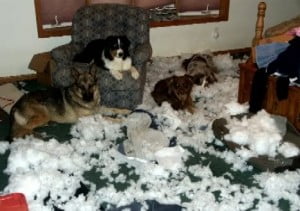Pet Advice Guides for Pet Owners
Destructive Dogs and chewing
 Some dogs wouldn’t dream of chewing anything up – others go for everything they can get their teeth on – your best trainers, the t.v. remote, the steering wheel in the car, their bed, a corner of the sofa even. When it’s not a puppy thing and your dog is still a chewer when he’s grown up, is there anything you can do to stop him?
Some dogs wouldn’t dream of chewing anything up – others go for everything they can get their teeth on – your best trainers, the t.v. remote, the steering wheel in the car, their bed, a corner of the sofa even. When it’s not a puppy thing and your dog is still a chewer when he’s grown up, is there anything you can do to stop him?
You’ve tried providing bones and chew sticks and pigs ears and these are enthusiastically demolished. You take him out for long walks and give him endless attention. When he still starts on the furniture as soon as your back is turned, you being to despair – what’s causing him to be like this? Is it your fault? Are you doing something wrong? The short answer is ‘No’. Some dogs just do like to chew. What starts out as something that happens during teething, just goes on and on. It feels good and it becomes a habit. In any litter of puppies there will almost certainly be a persistent chewer among them. In the natural world, what would it matter? Chewing is normal behaviour to a dog. When a dog destroys our possessions and home there is a lot of stress. You love him but……he’ll have to go. When we get a stray dog in that destroys the pen the first day, we know just why he’s been dumped.
It may be a slight calcium deficiency that sets a dog on this path. Each newborn puppy will latch on to a teat and suckle that particular one for the duration of time spent with mom. Some teats have more milk than others and the puppies do better. The runts of the litter will not get a look in at the best of the milk bar. They have to make do with whatever teat they can find, the ones at the back with not so much milk. The big, bouncing pick of the litter pups don’t seem to turn into chewers – but this may be coincidence. It’s only a theory that the ‘needy’ ones chew but that’s how it seems to be. Up the nutritional intake, make sure it’s as good as you can make it. Organic or natural food is best. Goats milk and porridge are good for dogs that chew. A lot of dogs like a handful of plain uncooked oats for breakfast. Raw meat is good. Cod liver oil. A seaweed supplement. These all help.
One of our own Miss Whippets has always had a tendency towards destruction, something that’s quite rare among the whippet fraternity. We’ve never known another mini-gazehound like her – she prefers plastic biros to pigs ears and if she can get a mobile phone, she’s in heaven. After she happily destroyed a Blackberry we were always on a high state of alert. Library books? Yum, yum. When we bought a Tuffi bed, which was guaranteed indestructible, she chewed a corner off the first day. The manufacturers were in shock. A whippet did this? ‘Fraid so.
So is there anything to be done, or do you have to remember to put everything out of reach forever? Don’t worry, you can cure a chewer. Reproachful persistence is the first stance to adopt. When you find him chewing something he shouldn’t, take it away with a firm, growling ‘No!’. Straight away replace whatever it was with a chewy from the good-boy list (marrow bones, rubber toys, hide chews etc.) and praise the dog lavishly when he starts in on his new toy. Only give one or two chews at a time and take them away and replace them frequently. It’s a diversionary tactic that often works.
It must be a bit confusing for our canine pals when chewing up a piece of rawhide is fine but your best shoes or the leather sofa are a no-no. Be consistent with what’s acceptable and what’s not. Playing with your dog with his chew toys helps him understand that these are o.k. The cupboard door handles are not. You can also use verbal commands and praise. When you give him a chew stick to play with, try saying the word ‘chewie’ and ‘good boy.’ Tie them to a bit of string and drag them around for him to ‘catch’. Good boy. Eventually ‘chewie’ will mean playtime.
So far it’s been mostly diversionary tactics but helping this along by making the things he chews downright unnatractive is part of the deal. Paint the things he goes for with something hot, bitter and absolutely horrid. We used Tabasco sauce and various relishes and tart lemon juice. Anything that will make him jump back and say ‘Yuk! What was that?’ Of course, painting the edges of your antique wooden cabinets with Hendersons Relish may not be the most desirable thing to do, but it will save them. Strong scents also work. Tea tree oil, perfume, disinfectant. Check first that no damage will be done to the surface you are spraying. It might be enough to water the scent down and it will still work. It’s a sensory direction field you’re aiming for – nice things to chew smell dog-good, bad things to chew smell dog-bad.
When your dog has a shoe fetish spraying with scent or oil might not be possible. Dogs particularly love shoes because they smell of you. My people, I love them. In this case there’s only one thing to do – form a new shoe saving habit yourself – always put them out of reach!
